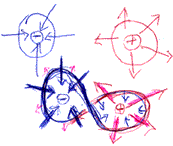Chapter 6 - Wave Theory and
Electricity
(Continued —
Page 5)
Printer-Friendly Version
Energetic matter has no rigid borders, even in seemingly
well-defined formations (see the chapters on the photon and
the universe). It influences distant formations by its energetic
space and circulate between them in a manner similar to the
wave circulation of energetic matter. By rubbing ebonite,
we add energy, align its paths and enlarge its space, enabling
it to come in contact with objects that accept its excess
energy (static electricity) (picture below).

A closed swirl (wave) cannot accept energy beyond its capacity
(the common energetic space of a closed circulation), but
additional energy enlarges van der Waals’ peripheral
atom circulation energy spaces and energetic paths. When we
 place
two sweaters together, their shared energetic space is larger
than the sum of their individual spaces. When separated, their
energetic level (space) is diminished and excess energy is
expelled as visible sparks. place
two sweaters together, their shared energetic space is larger
than the sum of their individual spaces. When separated, their
energetic level (space) is diminished and excess energy is
expelled as visible sparks.
An electric charge creates an electric field in the surrounding
space. Michael Faraday (1791 – 1867) proposed a map
of electric field lines (lines of force). These are always
directed away from a positive charge and toward a negative
charge. Wave theory explains these forces (see picture above-right).
Back to
Top
Dr. Chaim Tejman, Copyright©
2001. All rights reserved.
[Index]
[Introduction]
[Summary] [Wave
Formation] [Photons] [Gravitation]
[Time]
[Atoms] [Life]
[Cancer] [Fundamental
Force] [Gender/Why Sex?]
[Sexual Reproduction]
[Schrodinger & Heisenberg]
[Creation] [Supernova]
[Dark
Matter & Astronomy] [Speed
of Light] [Cloud Formations]
[Natural Disasters] [Global
Warming] [Thermodynamics]
[Backward Time] [Quantum
Mechanics] [Compton Effect]
[Equations] [Predictions]
[Academic Correspondences] [Contact]
[Links] [Mysteries] |